Trey'von Knowles's Blog, page 29
December 30, 2024
Godfrey of Bouillon
Godfrey of Bouillon:
Godfrey of Bouillon was not Jewish, but he was a leader of the First Crusade and the first Latin ruler of Jerusalem.
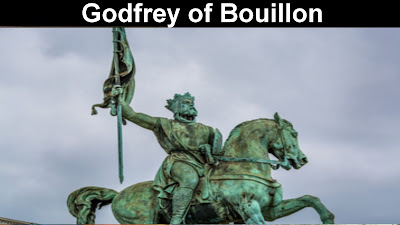
Godfrey of Bouillon (1060 – 18 July 1100) was a preeminent leader of the First Crusade, and the first ruler of the Kingdom of Jerusalem from 1099 to 1100. Although initially reluctant to take the title of king, he agreed to rule as prince (princeps) under the title Advocatus Sancti Sepulchri, or Advocate of the Holy Sepulchre.
He was the second son of Eustace II, Count of Boulogne in France. He received an inheritance from his mother's family in 1076 when he became Lord of Bouillon, which is now in Belgium. In 1087 Emperor Henry IV also confirmed him as Duke of Lower Lorraine, in reward for his support during the Great Saxon Revolt.
Along with his brothers Eustace III and Baldwin of Boulogne, Godfrey joined the First Crusade in 1096. He took part in actions at Nicaea, Dorylaeum, and Antioch, before playing a key role during the capture of Jerusalem in 1099. When Raymond IV, Count of Toulouse declined the offer to become ruler of the new kingdom, Godfrey accepted the role and secured his kingdom by defeating the Fatimids at Ascalon a month later, bringing the First Crusade to an end. He died in July 1100 and was succeeded by his brother Baldwin as King of Jerusalem.
Early life:
Godfrey of Bouillon was born around 1060, second son of Eustace II, Count of Boulogne and Ida, daughter of the Lotharingian duke Godfrey the Bearded and his first wife, Doda. He was probably born in Boulogne-sur-Mer, although one 13th-century chronicler cites Baisy, a town in what is now Walloon Brabant, Belgium. As second son, he had fewer opportunities than his older brother. However his maternal uncle, Godfrey the Hunchback, died childless and named his nephew, Godfrey of Bouillon, as his heir and next in line to his Duchy of Lower Lorraine. This duchy was an important one at the time, serving as a buffer between the French kingdom and the German lands.
In fact, Lower Lorraine was so important to the Holy Roman Empire that in 1076 Henry IV (reigned 1056–1105), then King of the Romans and future emperor, decided to place it in the hands of his own son and give Godfrey only Bouillon and the Margraviate of Antwerp, allegedly as a test of his loyalty. Godfrey supported Henry even during his struggle with Pope Gregory VII during the Investiture Controversy. Godfrey fought alongside Henry and his forces against Rudolf of Swabia and in Italy when Henry captured Rome itself.
A major test of Godfrey's leadership skills was shown in his battles to defend his inheritance against a significant array of enemies. In 1076 he had succeeded as designated heir to the Lotharingian lands of his uncle, Godfrey the Hunchback, and Godfrey was struggling to maintain control over the lands that Henry IV had not taken away from him. Claims were raised by his aunt Margravine Matilda of Tuscany, cousin Count Albert III of Namur, and Count Theoderic of Veluwe. This coalition was joined by Bishop Theoderic of Verdun, and two minor counts attempting to share in the spoils, Waleran I of Limburg and Arnold I of Chiny.
As these enemies tried to take away portions of his land, Godfrey's brothers, Eustace and Baldwin, both came to his aid. Following these long struggles and proving that he was a loyal vassal to Henry IV, Godfrey finally gained Lower Lorraine in 1087.
First Crusade:
The "sword of Godfrey of Bouillon" displayed at the Church of the Holy Sepulchre in Jerusalem since 1808 (1854 photograph)
In 1095 Pope Urban II called for military action in order to liberate Jerusalem and aid the Byzantine Empire, which in the years since 1071 had lost large swathes of territory to the Seljuk Empire. Godfrey either sold or mortgaged most of his estates to the bishops of Liège and Verdun and used the money to recruit an army of Crusaders. He was joined by his older brother, Eustace, and his younger brother, Baldwin, who had no lands in Europe and was seeking them in the Holy Land. Others did the same, the largest being that raised by Raymond IV, Count of Toulouse, who at 55 was the oldest and most experienced of the Crusader nobles. As a result, he expected to lead the expedition, a claim boosted by the presence of Adhemar of Le Puy, the papal legate who travelled with him. Significant forces also accompanied Bohemond of Taranto, a Norman knight from southern Italy, and Robert II, Count of Flanders.
Following advice provided by Pope Urban, most of these armies set out in mid-summer and headed for Constantinople where they could expect assistance from Emperor Alexios I Komnenos. Each travelled separately, since it was impossible for one region to feed and supply such large numbers on their own; the first to leave in spring 1096 was what became known as the People's Crusade, an army of 20,000 low ranking knights and peasants which journeyed through the Rhineland, then headed for Hungary. Most of those from southern and northern France sailed from Brindisi across the Adriatic Sea, while Godfrey and his two brothers, leading an army from Lorraine reportedly 40,000 strong, set out in August 1096 following the route taken by the People's Crusade.
Pope Urban II's call for the crusade spurred a wave of violence against Jews across Europe, beginning with Rouen in December 1095. In the spring and early summer of 1096, members of the People's Crusade plundered and massacred Jewish communities during the Rhineland massacres.
After the People's Crusade entered Hungary in June, a series of incidents had culminated in a full-scale battle with their hosts and the deaths of over 10,000 Crusaders; as a result, when Godfrey and his troops approached the border in September, it took several days of negotiations before they were allowed in. He finally reached Constantinople in November, shortly after those led by Hugh of Vermandois while others arrived over the next few months. Unlike the limited numbers he had anticipated, by May 1097 Alexios found himself with over 4,000 to 8,000 mounted knights and 25,000 to 55,000 infantry camped on his doorstep. This mattered because the two sides had different goals; Alexius simply wanted help in retaking Byzantine lands lost to the Seljuk Turks, while the Crusaders sought to liberate the Holy Land from the Muslims. When Alexios demanded an oath of loyalty, Godfrey and most of the Crusaders agreed to a modified version in which they promised to restore some lands to the Emperor, Raymond of Toulouse being a notable exception: he would just promise to do the Emperor no harm.
Capture of Nicaea and Antioch:
In February 1097, Godfrey and his army crossed the Bosporus Straits, where he was joined by Bohemund, Robert of Flanders and Hugh of Vermandois. Accompanied by Byzantine soldiers, in early May the Crusaders invested Nicaea, a city close to Constantinople captured by the Turks in 1085. Godfrey and his troops played a minor role, with Bohemond successfully commanding much of the action but as the Crusaders were about to storm the city, they noticed the Byzantine flag flying from the top of the walls. Wanting to minimise damage to what was an important Byzantine city and suspecting the Crusaders would demand a heavy ransom for handing it over, Alexios had made a separate peace with the Turkish garrison. Although the majority of the Crusader leaders accepted Alexios' right to do so, it was an illustration of the level of mutual suspicion between the two sides.
1883 portrayal of Godfrey and other leaders of the First Crusade, by Alphonse-Marie-Adolphe de Neuville
Godfrey continued to play a minor, yet significant, role in the battles against the Seljuks until the Crusaders finally reached Jerusalem in 1099. At Dorylaeum in July 1097, he helped relieve the vanguard at Dorylaeum which had been pinned down by a Turkish force under Kilij Arslan I, then sacked their camp. After this battle and during the trek through Asia Minor, some sources suggest that Godfrey was attacked by a bear and received a serious wound which incapacitated him for a time.
Godfrey also took part in the Siege of Antioch, which began in October 1097 and did not surrender until June 1098 after long and bitter fighting. During the winter, the crusading army came close to starvation and many returned to Europe, while Alexios assumed all was lost at Antioch and failed to provide them with supplies as promised. When the city finally fell, Bohemond claimed it for himself and refused to hand it over to the Emperor citing the Emperor's failure to help the crusaders at Antioch as breaking the oath; after repulsing a Muslim force from Mosul led by Kerbogha, Antioch was secured.
March on Jerusalem:
After this victory, the Crusaders were divided over their next course of action. The bishop of Le Puy had died at Antioch. Bohemond decided to remain behind in order to secure his new principality; and Godfrey's younger brother, Baldwin, also decided to stay in the north in the Crusader state he had established at Edessa. Most of the foot soldiers wanted to continue south to Jerusalem, but Raymond IV of Toulouse, by this time the most powerful of the princes, having taken others into his employ, such as Tancred, hesitated to continue the march. After months of waiting, the common people on the crusade forced Raymond to march on to Jerusalem, and Godfrey quickly joined him. As they travelled south into Palestine, the Crusaders faced a new enemy. No longer were the Seljuk Turks the rulers of these lands. Now the Christian army had to deal with armies of North African Muslims called Fatimids, who had adopted the name of the ruling family in Cairo, Egypt. The Fatimids had taken Jerusalem in August 1098. The Crusaders would be battling them for the final prize of the First Crusade in the siege of Jerusalem.
It was in Jerusalem that the legend of Godfrey of Bouillon was born. The army reached the city in June 1099 and built a wooden siege tower (from lumber provided by some Italian sailors who intentionally scrapped their ships) to get over the walls. The major attack took place on 14 and 15 July 1099. Godfrey and some of his knights were the first to take the walls and enter the city. It was an end to three years of fighting by the Crusaders, but they had finally achieved what they had set out to do in 1096—to recapture the Holy Land and, in particular, the city of Jerusalem and its holy sites, such as the Holy Sepulchre, the empty tomb of Jesus Christ. Godfrey endowed the hospital in the Muristan after the First Crusade.
Kingdom of Jerusalem:
Godfrey of Bouillon being created the Lord of the city. From the Histoire d'Outremer by William of Tyre, detail of an historiated initial S, in a British Library Manuscript in the Yates Thompson Collection (No. 12, fol. 46), 13th century.
Once the city was returned to Christian rule, some form of government had to be set up. On 22 July 1099, a council was held in the Church of the Holy Sepulchre and after Raymond of Toulouse had refused the crown, Godfrey agreed to become ruler. However, he preferred the title Advocate of the Holy Sepulchre to that of king, allegedly refusing to "wear a crown of gold where his Saviour had worn a crown of thorns. Both the meaning and usage of his title is disputed. Some of the original chroniclers used the more ambiguous term princeps, or his previous rank of duke. Later chroniclers who did not participate in the First Crusade suggest he took the title of rex, "king".
During his short reign, Godfrey had to defend the new kingdom against the Fatimids of Egypt, who were defeated at the Battle of Ascalon in August. He also faced opposition from Dagobert of Pisa, the Latin Patriarch of Jerusalem, who was allied with Tancred. Although the Latins came close to capturing Ascalon, Godfrey's attempts to prevent Raymond of St. Gilles from securing the city for himself meant that the town remained in Muslim hands, destined to be a thorn in the new kingdom's side for years to come.
In 1100, Godfrey was unable to directly expand his new territories through conquest. However, his impressive victory in 1099 and his subsequent campaigning in 1100 meant that he was able to force Acre, Ascalon, Arsuf, Jaffa, and Caesarea to become tributaries. Meanwhile, the struggle with Dagobert continued, although the terms of the conflict are difficult to trace. Dagobert may well have envisaged turning Jerusalem into a fiefdom of the pope, but his full intentions are not clear. Much of the evidence for this comes from William of Tyre, whose account of these events is troublesome; it is only William who tells us that Dagobert forced Godfrey to concede Jerusalem and Jaffa, while other writers such as Albert of Aachen and Ralph of Caen suggest that both Dagobert and his ally Tancred had sworn an oath to Godfrey to accept only one of his brothers or blood relations as his successor. Whatever Dagobert's schemes, they were destined to come to naught. Being at Haifa at the time of Godfrey's death, he could do nothing to stop Godfrey's supporters, led by Warner of Grez, from seizing Jerusalem and demanding that Godfrey's brother Baldwin should succeed to the rule. Dagobert was subsequently forced to crown Baldwin as the first Latin king of Jerusalem on 25 December 1100.
Death:
Cenotaph of Godfrey of Bouillon in the Church of the Holy Sepulchre (1870, after a 15th-century woodcut)
The Arab chronicler Ibn al-Qalanisi reported that "In this year [1099], Godfrey, lord of Jerusalem, appeared before the fortified port of 'Akkā [Acre] and made an assault upon it, but was struck by an arrow, which killed him". While this claim is repeated in other Muslim sources, it does not appear in Christian chronicles; Albert of Aix and Ekkehard of Aura suggest Godfrey fell ill while visiting Caesarea in June 1100 and died in Jerusalem on 18 July.
Suggestions he was poisoned are unlikely and it is more probable he died from a disease similar to typhoid. Godfrey never married.
https://crosssides.blogspot.com/
December 29, 2024
Elon Musk's Forbidden Knowledge
Elon Musk's Forbidden Knowledge by Trey Knowles

Lex Luthor is a supervillain appearing in American comic books published by DC Comics.
What is Lex Luthor's power?
Lex Luthor - Given his high profile as a supervillain, however, he has often come into conflict with Batman and other superheroes in the DC Universe. Lex Luthor is physically an ordinary human and has no natural superpowers, but he is a genius with a high aptitude for business, politics, science, and technology.
What is Elon Musk's power?
Elon Musk - Given his high profile as a supervillain, now, he will come into conflict with Vladimir Putin and other Supervillain in the world. Elon Musk is physically an ordinary human and has no natural superpowers, but he is a genius with a high aptitude for business, politics, science, and technology.
Elon Musk is involved in several space-related projects that could be used for military purposes, including:
SpaceX spy satellite network
SpaceX is building a network of spy satellites for a US intelligence agency. The satellites can track ground targets and share that data with the US military and intelligence agencies.
Starship
SpaceX is developing Starship, a fully reusable rocket that could be used to transport people to Mars. SpaceX has been testing Starship more frequently in recent months, possibly in response to a warning from the Russian ambassador to Washington that Ukraine's use of SpaceX's satellite system could lead to a nuclear response from Russia.
Think on this:
Where does Elon Musk's Forbidden Knowledge come from?
God spirit and character is Holy and does not do evil, so be watchful and see who is ordering Elon Musk steps.
Whatever Elon Musk intentions are it will lead to destruction.
Note: We have one savior who saved the world already, Jesus Christ is that savior.
Be wise as a serpent but innocent as a dove and take note of this:
Allegory Note: Lex Luthor was the enemy to Superman.
Note: There is a way that seems right to a man, but its end is the way of death” is a verse from the Bible, Proverbs 14:12. The verse is a warning that people can be deceived by their own perceptions and that the true nature of a path is only revealed in its outcome.
In the Book of Enoch, Azazel the falling angel is responsible for teaching people to make weapons and cosmetics, for which he was cast out of heaven.
What is Elon Musk’s doing in space?
Where does Elon Musk's Forbidden Knowledge come from?
Be watchful and you decide.
https://crosssides.blogspot.com/
December 27, 2024
Europe's Great Famine and Plagues
Great Famine of Europe in 1315–1317:
The Great Famine of 1315–1317 (occasionally dated 1315–1322) was the first of a series of large-scale crises that struck parts of Europe early in the 14th century. Most of Europe (extending east to Poland and south to the Alps) was affected. The famine caused many deaths over an extended number of years and marked a clear end to the period of growth and prosperity from the 11th to the 13th centuries.

The Great Famine started with bad weather in spring 1315. Crop failures lasted through 1316 until the summer harvest in 1317, and Europe did not fully recover until 1322. Crop failures were not the only problem; cattle disease caused sheep and cattle numbers to fall as much as 80 per cent. The period was marked by extreme levels of crime, disease, mass death, and even cannibalism and infanticide. The crisis had consequences for the Church, state, European society, and for future calamities to follow in the 14th century.
The Bubonic Plague:
The Black Death was a bubonic plague pandemic that occurred in Europe from 1346 to 1353. It was one of the most fatal pandemics in human history; as many as 50 million people perished, perhaps 50% of Europe's 14th century population. The disease is caused by the bacterium Yersinia pestis and spread by fleas and through the air. One of the most significant events in European history, the Black Death had far-reaching population, economic, and cultural impacts. It was the beginning of the second plague pandemic. The plague created religious, social and economic upheavals, with profound effects on the course of European history.
The origin of the Black Death is disputed. Genetic analysis suggests Yersinia pestis bacteria evolved approximately 7,000 years ago, at the beginning of the Neolithic, with flea-mediated strains emerging around 3,800 years ago during the late Bronze Age. The immediate territorial origins of the Black Death and its outbreak remain unclear, with some evidence pointing towards Central Asia, China, the Middle East, and Europe.
The pandemic was reportedly first introduced to Europe during the siege of the Genoese trading port of Kaffa in Crimea by the Golden Horde army of Jani Beg in 1347. From Crimea, it was most likely carried by fleas living on the black rats that travelled on Genoese ships, spreading through the Mediterranean Basin and reaching North Africa, West Asia, and the rest of Europe via Constantinople, Sicily, and the Italian Peninsula.
There is evidence that once it came ashore, the Black Death mainly spread from person-to-person as pneumonic plague, thus explaining the quick inland spread of the epidemic, which was faster than would be expected if the primary vector was rat fleas causing bubonic plague. In 2022, it was discovered that there was a sudden surge of deaths in what is today Kyrgyzstan from the Black Death in the late 1330s; when combined with genetic evidence, this implies that the initial spread may have been unrelated to the 14th century Mongol conquests previously postulated as the cause.
The Black Death was the second great natural disaster to strike Europe during the Late Middle Ages (the first one being the Great Famine of 1315–1317) and is estimated to have killed 30% to 60% of the European population, as well as approximately 33% of the population of the Middle East.
There were further outbreaks throughout the Late Middle Ages and, also due to other contributing factors (the Crisis of the Late Middle Ages), the European population did not regain its 14th century level until the 16th century. Outbreaks of the plague recurred around the world until the early 19th century.
https://crosssides.blogspot.com/
December 26, 2024
Neanderthals and the Nephilim
Neanderthals and the Nephilim:
Neanderthals and the Nephilim are related in that they are both part of human history and could have produced offspring together:
Neanderthals:
Neanderthals are one of the closest ancient relatives of modern humans, along with the Denisovans. Scientific evidence suggests that Neanderthals and humans shared a common ancestor and interbred regularly.
Neanderthal DNA is DNA inherited from Neanderthals, an early human species that lived in Europe and Western Asia from about 400,000 years ago until they became extinct about 40,000 years ago:
Percentage:
Most people outside of Africa have about 1–2% Neanderthal DNA in their genome. People from African populations have little to no Neanderthal DNA.
Origin:
Neanderthals and modern humans interbred, exchanging DNA through a process called introgression. This mixing likely occurred in Europe or the Middle East between 45,000 and 60,000 years ago.
Benefits:
Neanderthal genes may have helped humans adapt to new diets, survive, and become smarter. They may also play a role in the immune system, helping the body fight off viruses and bacteria.
Genetic evidence:
Neanderthal nuclear DNA shows evidence of a small population size, including genetic evidence of incest.
Testing:
Direct-to-consumer genetic testing companies can report how much Neanderthal DNA a person has.
Nephilim:
The Nephilim are said to be the offspring of the "sons of God" and the "daughters of men". Some interpret the "sons of God" to be angels or fallen angels, and the "daughters of men" to be human women. This view is popular and is described in the First Book of Enoch, a noncanonical Jewish text.
One theory suggests that after being expelled from Eden, Adam and Eve's descendants interbred with other hominids, including Neanderthals, resulting in the Nephilim. This could explain the genetic evidence of contributions from a larger hominid population in the present human population.
The Nephilim are mysterious beings or people in the Hebrew Bible (the Christian Old Testament) who are described as being unusually large and strong:
Appearance:
The Nephilim are traditionally depicted as being of great size and strength, or alternatively beings of great power and authority.
Origin:
The origins of the Nephilim are disputed. Some believe they were the offspring of the unnatural unions between angels and women, as described in Genesis 6. Others believe the word "Nephilim" means "the fallen ones" and that the offspring "fell short" of their fathers in some way.
Bible references:
The Nephilim are referenced in Genesis, Numbers, and possibly Ezekiel. In Numbers 13, Israelite spies encounter the Nephilim and are reminded of how important it is to trust in God's promises.
Translation:
The Hebrew word nefilim is sometimes translated as “giants” or taken to mean “the fallen ones”. In some Bibles, the word is narrowly translated as giants, but in others it is left untranslated.
The identity of the Nephilim is a source of debate for many theologians and scholars.
The children of the Nephilim are called the Elioud, and are considered a separate race from the Nephilim. However, they share the same fate as the Nephilim.
The Nephilim are a group of people in the Bible that are described as the offspring of sexual relations between angels and women. The Bible mentions the Nephilim in Genesis 6:4 and Numbers 13:32–33.
Here are some interpretations of the Nephilim:
Fallen ones:
Some interpret the Nephilim as "fallen ones" who were either warriors who "fell upon" their enemies or people who had fallen far from God.
Sons of God and daughters of men:
Some interpret the Nephilim as the offspring of the unions described in Genesis 6:4. In this view, the "sons of God" could refer to angels or fallen angels, and the "daughters of men" could refer to human women.
Descendants of Sodom and Gomorrah:
Some interpret the Nephilim as descendants of Sodom and Gomorrah, and other cities of the plain. In this view, the Nephilim were 100% human descendants of Adam who fell far from God.
According to the Book of Enoch, the Nephilim taught humans many arts and technologies, including:
Weaponry: The Nephilim taught humans how to make swords, knives, shields, and breastplates.
Cosmetics: The Nephilim taught humans how to make cosmetics and beautify their eyelids.
Mirrors: The Nephilim taught humans about mirrors.
Sorcery: The Nephilim taught humans sorcery and other magical techniques.
The Nephilim were the offspring of unions between angels and human women. The angels, known as watchers, were sent to Earth to watch over humans but began to lust for human women. Their leader, Samyaza, encouraged them to defect to Earth and procreate with human women. The Nephilim were savage giants who endangered humanity. Eventually, God sent a Great Flood to destroy the Nephilim.
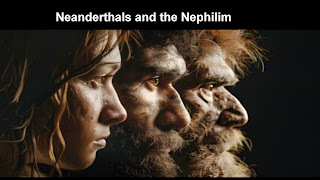
https://crosssides.blogspot.com/
The Khazars
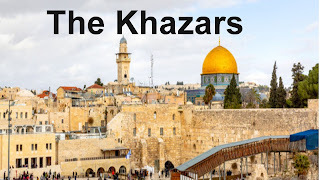
Revelation 2:9 says. I know your afflictions and your poverty—yet you are rich! I know about the slander of those who say they are Jews and are not, but are a synagogue of Satan.
The Khazars were a nomadic Turkic people who established a commercial empire in the late 6th century CE. They were one of the first groups to convert to Judaism, and their history is linked to the "Khazarian hypothesis" that Eastern European Jews are descended from them:
The Khazars were a confederation of tribes from the Caucasus, including Slavic, Scythian, Hunnic–Bulgar, Iranian, Alans, and Turkish. They were originally part of the western Turkic empire in Turkistan. In the late 6th century, they established a commercial empire in the southeastern part of modern European Russia, southern Ukraine, Crimea, and Kazakhstan. They fought wars with the Arabs in the 8th century.
The Khazars (/ˈxɑːzɑːrz/) were a nomadic Turkic people that, in the late 6th century CE, established a major commercial empire covering the southeastern section of modern European Russia, southern Ukraine, Crimea, and Kazakhstan. They created what, for its duration, was the most powerful polity to emerge from the break-up of the Western Turkic Khaganate. Astride a major artery of commerce between Eastern Europe and Southwestern Asia, Khazaria became one of the foremost trading empires of the early medieval world, commanding the western marches of the Silk Road and playing a key commercial role as a crossroad between China, the Middle East, and Kievan Rus'. For some three centuries (c. 650–965), the Khazars dominated the vast area extending from the Volga-Don steppes to the eastern Crimea and the northern Caucasus.
Khazaria long served as a buffer state between the Byzantine Empire, the nomads of the northern steppes, and the Umayyad and Abbasid Caliphates, having previously served as the Byzantine Empire's proxy against the Sasanian Empire. The alliance was dissolved around the year 900 when Byzantium began encouraging the Alans to attack Khazaria. This move aimed to weaken Khazaria's control over Crimea and the Caucasus, for the Empire sought an entente with the rising power of the Kievan Rus’ in the north—a region they hoped to convert to Eastern Christianity. Between 965 and 969, Sviatoslav I of Kiev, the ruler of Kievan Rus', along with his allies, conquered the capital, Atil, thus ending Khazaria's independence.
Determining the origins and nature of the Khazars is closely bound with theories of their languages. Still, it is a matter of intricate difficulty since no indigenous records in the Khazar language survived, and the state was polyglot and polyethnic. The native religion of the Khazars is thought to have been Tengrism like that of the North Caucasian Huns and other Turkic peoples. The polyethnic populace of the Khazar Khaganate appears to have been a multiconfessional mosaic of pagan, Tengrist, Jewish, Christian, and Muslim worshippers. Some of the Khazars (namely, the Kabars) joined the ancient Hungarians in the 9th century. The ruling elite of the Khazars was said by Judah Halevi and Abraham ibn Daud to have converted to Rabbinic Judaism in the 8th century, but the scope of the conversion to Judaism within the Khazar Khanate remains uncertain.
Where the Khazars dispersed after the fall of the Khanate is subject to many conjectures. Proposals have been made regarding the possibility of a Khazar factor in the ethnogenesis of numerous peoples, such as the Hazaras, Hungarians, the Kazakhs, the Cossacks of the Don region and Ukraine, the Muslim Kumyks, the Turkic-speaking Krymchaks and their Crimean neighbours the Crimean Karaites, the Moldavian Csángós, the Mountain Jews, and even some Subbotniks (based on their Ukrainian and Cossack origin).
The late 19th century saw the emergence of a theory that the core of today's Ashkenazi Jews are descended from a hypothetical Khazarian Jewish diaspora that migrated westward from modern-day Russia and Ukraine into modern-day France and Germany. Linguistic and genetic studies have not supported the theory of a Khazar connection to Ashkenazi Jewry. The theory still finds occasional support, but most scholars view it with considerable scepticism. The theory is sometimes associated with antisemitism and anti-Zionism.
In Oghuz Turkic languages, the Caspian Sea is still named the "Khazar Sea", an enduring legacy of the medieval Khazar state.
https://crosssides.blogspot.com/Edomites Idumaea

The Hebrew word Edom means "red", and the Hebrew Bible relates it to the name of its founder Esau, the elder son of the Hebrew patriarch Isaac, because he was born "red all over". As a young adult, he sold his birthright to his brother Jacob for a portion of "red pottage". The Tanakh describes the Edomites as descendants of Esau.
Edom (/ˈiːdəm/; Edomite: 𐤀𐤃𐤌 ʾDM; Hebrew: אֱדוֹם ʾĔḏōm, lit.: "red"; Akkadian: 𒌑𒁺𒈪 Údumi, 𒌑𒁺𒈬 Údumu; Ancient Egyptian: jdwmꜥ) was an ancient kingdom that stretched across areas in the south of present-day Jordan and Israel. Edom and the Edomites appear in several written sources relating to the late Bronze Age and to the Iron Age in the Levant, including the list of the Egyptian pharaoh Seti I from c. 1215 BC as well as in the chronicle of a campaign by Ramesses III (r. 1186–1155 BC), and the Tanakh.
Archaeological investigation has shown that the nation flourished between the 13th and the 8th centuries BC and was destroyed after a period of decline in the 6th century BC by the Babylonians. After the fall of the kingdom of Edom, the Edomites were pushed westward towards southern Judah by nomadic tribes coming from the east; among them were the Nabataeans, who first appeared in the historical annals of the 4th century BC and had already established their own kingdom in what used to be Edom by the first half of the 2nd century BC. More recent excavations show that the process of Edomite settlement in the southern parts of Judah and parts of the Negev down to Timna had started already before the destruction of the kingdom by Nebuchadnezzar II in 587/86 BC, both by peaceful penetration and by military means and taking advantage of the already-weakened state of Judah.
Once pushed out of their territory, the Edomites settled during the Persian period in an area comprising the southern hills of Judea down to the area north of Be'er Sheva. The people appear under a Greek form of their old name, as Idumeans or Idumaeans, and their new territory was called Idumea or Idumaea (Greek: Ἰδουμαία, Idoumaía; Latin: Idūmaea), a term that was used in the Hellenistic and Roman periods, also mentioned in the New Testament. During the 2nd century BC, the Edomites were forcibly converted to Judaism by the Hasmoneans and were incorporated into the Jewish population. Other scholars believe that the assimilation was voluntary.
Edom and Idumea are two related but distinct terms; they relate to a historically-contiguous population but to two separate, if adjacent, territories which the Edomites/Idumeans occupied in different periods of their history. The Edomites first established a kingdom ("Edom") in the southern area of modern-day Jordan and later migrated into the southern parts of the Kingdom of Judah ("Idumea", modern-day Mount Hebron)[dubious – discuss] when Judah was first weakened and then destroyed by the Babylonians in the 6th century BC.
The Edomites may have been connected with the Shasu and Shutu, nomadic raiders mentioned in Egyptian sources. Indeed, a letter from an Egyptian scribe at a border fortress in the Wadi Tumilat during the reign of Merneptah reports movement of nomadic "shasu-tribes of Edom" to watering holes in Egyptian territory. The earliest Iron Age settlements—possibly copper mining camps—date to the 11th century BC. Settlement intensified by the late 8th century BC, and the main sites so far excavated have been dated between the 8th and 6th centuries BC. The last unambiguous reference to Edom is an Assyrian inscription of 667 BC. Edom ceased to exist as a state when it was conquered by Nabonidus in the 6th century BC.
Edom is mentioned in Assyrian cuneiform inscriptions in the form 𒌑𒁺𒈪 Údumi and 𒌑𒁺𒈬 Údumu; three of its kings are known from the same source: Kaus-malaka at the time of Tiglath-pileser III (c. 745 BC), Aya-ramu at the time of Sennacherib (c. 705 BC), and Kaus-gabri at the time of Esarhaddon (c. 680 BC). According to the Egyptian inscriptions, the "Aduma" at times extended their possessions to the borders of Egypt.
The existence of the Kingdom of Edom was asserted by archaeologists led by Ezra Ben-Yosef and Tom Levy, by using a methodology called the punctuated equilibrium model in 2019. Archaeologists mainly took copper samples from Timna Valley and Faynan in Jordan’s Arava valley dated to 1300-800 BC. According to the results of the analysis, the researchers thought that Pharaoh Shoshenk I of Egypt (the Biblical "Shishak"), who attacked Jerusalem in the 10th century BC, encouraged the trade and production of copper instead of destroying the region. Tel Aviv University professor Ben Yosef stated "Our new findings contradict the view of many archaeologists that the Arava was populated by a loose alliance of tribes, and they’re consistent with the biblical story that there was an Edomite kingdom here.
Idumaea
After the conquest of Judah by the Babylonians, Edomites settled in the region of Hebron. They prospered in this new country, called by the Greeks and Romans "Idumaea" or "Idumea", for more than four centuries. Strabo, writing around the time of Jesus, held that the Idumaeans, whom he identified as of Nabataean origin, constituted the majority of the population of western Judea, where they commingled with the Judaeans and adopted their customs, a view not necessarily shared by modern scholarly works.
https://crosssides.blogspot.com/December 25, 2024
Apostle Peter And The Last Supper
"Apostle Peter and the Last Supper" refers to a story, often depicted in film or literature, where the Apostle Peter recounts his experiences during Jesus' final meal, the Last Supper, while imprisoned and reflecting on his life with Jesus, typically focusing on his personal connection to Jesus and the significant moments leading up to his own impending death, often attempting to convert his jailer through these retellings.
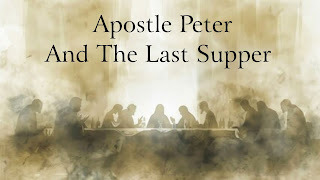
Key points about this narrative:
1. Focus on Peter's perspective:
The story primarily centers around Peter's memories of the Last Supper, highlighting his emotions, thoughts, and personal relationship with Jesus during that pivotal event.
2. The theme of faith and conversion:
As Peter shares his story with his jailer, it often serves as a powerful tool for conversion, illustrating the transformative power of faith in Jesus.
3. Setting in prison:
The narrative usually takes place in a prison cell, where Peter is awaiting execution, adding a layer of introspection and gravity to his reflections.
Movie Watch Below after skipping Ad: Apostle Peter And The Last Supper!function(r,u,m,b,l,e){r._Rumble=b,r[b]||(r[b]=function(){(r[b]._=r[b]._||[]).push(arguments);if(r[b]._.length==1){l=u.createElement(m),e=u.getElementsByTagName(m)[0],l.async=1,l.src="https://rumble.com/embedJS/u2kzfpi&qu..., document, "script", "Rumble");Rumble("play", {"video":"v5yaxdk","div":"rumble_v5yaxdk"});https://crosssides.blogspot.com/
December 24, 2024
Ottoman Empire Christian Genocide
While most of the world’s historians accepted the narrative that the Ottoman Turkish government had carried out a deliberate, pre-planned, systematic “genocide,” there were some—especially in Turkey—who disputed this. So, having no real knowledge or opinion either way, we decided to take a look at the vast, accessible documentation, in Turkey, the United States and Western Europe, and make up our own minds.
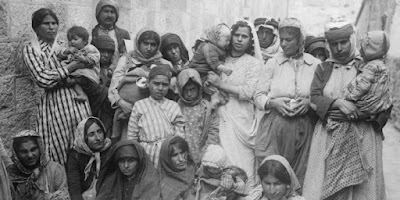
The campaign of mass murder and ethnic cleansing was carried out, in staggered fashion, over a thirty-year period, between 1894 and 1924. It encompassed not only Turkey’s Armenians but also all the other Christian communities in the country, primarily the Greeks, but also the various Assyrian sects.
The process of ethnic-religious cleansing was characterized by rounds of deliberate large-scale massacre, alongside systematic expulsions, forced conversions, and cultural annihilation that together amounted to genocide. At the beginning of this period, Christians had constituted about 20 percent of the population of Asia Minor; by 1924 the proportion of Christians in Turkey had fallen to 2 percent.
The destruction of the Christian communities was the result of the deliberate policy of three successive Ottoman and Turkish governments –Abdülhamid II in 1894–1896, the CUP (the Young Turks) from 1914–1918, and the Nationalist regime under Ataturk during 1919–1924 –a policy that most of the country’s Muslim inhabitants did not oppose, and many enthusiastically supported.
The murders, expulsions, and forced conversions were ordered by government officials and carried out by other officials, soldiers, gendarmes, policemen and, often, tribesmen and the civilian inhabitants of towns and villages.
All of this occurred with the active participation of Muslim clerics and the encouragement of the Turkish-language press. This, we believe, is the inescapable conclusion to be drawn from the massive documentation we consulted, some of it seen and used for the first time.
https://crosssides.blogspot.com/December 23, 2024
White Slavery in the Ottoman Empire
White Slavery in the Ottoman Empire:
White slavery (also white slave trade or white slave trafficking) refers to the enslavement of any of the world's European ethnic groups throughout human history, whether perpetrated by non-Europeans or by other Europeans. Slavery in ancient Rome was frequently dependent on a person's socio-economic status and national affiliation and thus included European slaves.
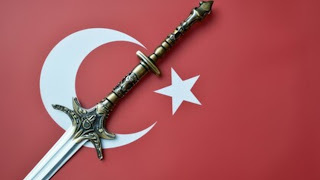
It was also common for European people to be enslaved and traded in the Muslim world; European women, in particular, were highly sought-after to be concubines in the harems of many Muslim rulers. Examples of such slavery conducted in Islamic empires include the Arab slave trade, the Barbary slave trade, the Ottoman slave trade, and the Black Sea slave trade, among others.
Many different types of white people were enslaved. On the European continent under feudalism, there were various forms of status applied to people (such as serf, bordar, villein, vagabond, and slaves) who were indentured or forced to labor without pay.
During the Arab slave trade, Europeans were among those traded by the Arabs. The term Saqaliba (Arabic: صقالبة) was often used in medieval Arabic sources to refer specifically to Slavs being traded by the Arabs, but it could also refer more broadly to Central, Southern, and Eastern Europeans who were also traded by the Arabs, as well as all European slaves in some Muslim-controlled regions like Spain, including those abducted from raids on Spanish Christian kingdoms. During the era of the Fatimid Caliphate (909–1171), the majority of slaves were Europeans taken from European coasts and during conflicts.
Similarly, the Ottoman slave trade that included European captives was often fueled by raids into European territories or were taken as children in the form of a blood tax from the families of citizens of conquered territories to serve the empire for a variety of functions. In the mid-19th century, the term 'white slavery' was used to describe the Christian slaves that were sold into the Barbary slave trade in North Africa.
Slavery was a major institution and a significant part of the Ottoman Empire's economy and traditional society. The main sources of slaves were wars and politically organized enslavement expeditions in the Caucasus, Eastern Europe, Southern Europe, Central Europe, Southeast Europe, the Western Mediterranean and Africa. It has been reported that the selling price of slaves decreased after large military operations.
In Constantinople (present-day Istanbul), the administrative and political center of the Ottoman Empire, about a fifth of the 16th- and 17th-century population consisted of slaves. Statistics of these centuries suggest that Istanbul's additional slave imports from the Black Sea slave trade have totaled around 2.5 million from 1453 to 1700.
Individual members of the Ottoman slave class, called a kul in Turkish, could achieve high status in some positions. Eunuch harem guards and janissaries are some of the better known positions an enslaved person could hold, but enslaved women were actually often supervised by them. However, women played and held the most important roles within the harem institution.
A large percentage of officials in the Ottoman government were bought as slaves, raised free, and integral to the success of the Ottoman Empire from the 14th to 19th centuries. Many enslaved officials themselves owned numerous slaves, although the Sultan himself owned by far the most.
By raising and specially training slaves as officials in palace schools such as Enderun, where they were taught to serve the Sultan and other educational subjects, the Ottomans created administrators with intricate knowledge of government and fanatic loyalty.
Other slaves were simply laborers used for hard labor, such as for example agricultural laborers and galley slaves. Female slaves were primarily used as either domestic house servants or as concubines (sex slaves), who were subjected to harem gender segregation.
While there were slaves of many different ethnicities and race was not the determining factor in who could be enslaved, there was still a racial hierarchy among slaves since slaves were valued and assigned tasks and considered to have different abilities due to racial stereotypes.
Even after several measures to ban the slave trade and restrict slavery, introduced due to Western diplomatic pressure in the late 19th century, the practice continued largely unabated into the early 20th century.
https://crosssides.blogspot.com/December 21, 2024
Christianity and Colonialism
Colonial missionaries were religious figures who played a central role in European colonialism, spreading Christianity and influencing the cultural and political landscapes of colonized regions:
Missionary activity and colonialism:
Missionary work was a key part of European colonialism, especially in the British Empire. Missionaries were often involved in the early stages of imperial expansion, and their work provided a sense of moral authority and justice for British missionaries and their supporters.

Missionary goals:
Missionaries' goals included converting as many native people to Christianity as possible. They believed that converting native people was so important that they sometimes felt justified in using force or violence.
Missionary orders:
Most missions in the Americas and other colonies were run by religious orders, such as the Franciscans, Augustinians, Jesuits, and Dominicans.
Missionary impact:
The impact of missionaries on colonized regions included:
Cultural change: Missionaries influenced the spiritual customs of American Indian tribes, and some Indian spiritual customs blended with Christianity.
Resistance: Native American resistance to the missions and colonial policies resulted in rebellions that could take years or decades to resolve.
Some missionaries opposed the oppressive rule:
Some missionaries opposed oppressive colonial rule, worked to maintain the rights of the colonized, and tried to respect and understand local cultures.
Note: It is written in Matthew 16:24-25.
24 Then Jesus said to his disciples, “Whoever wants to be my disciple must deny themselves and take up their cross and follow me. 25 For whoever wants to save their life will lose it, but whoever loses their life for me will find it.
Note: In other words, if a man is not denying himself he is wicked how can he do missionary work without doing the missionary work on himself?
Note: It is written in Matthew 10:13-15.
13 If the home is deserving, let your peace rest on it; if it is not, let your peace return to you. 14 If anyone will not welcome you or listen to your words, leave that home or town and shake the dust off your feet. 15 Truly I tell you, it will be more bearable for Sodom and Gomorrah on the day of judgment than for that town.
Note: This is how you do Missionary work outside of this is wicked.



